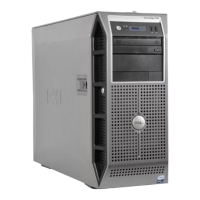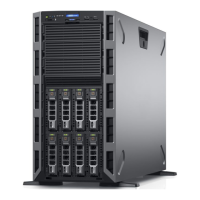6 PowerEdge T320 Technical Guide
Key technologies
Table 1 summarizes key technologies used in the Dell PowerEdge T320 tower server.
Table 1. Key technologies
Intel Xeon E5-2400 and E5-2400 v2 product families, the Intel Xeon E5-1410
processor, and the Intel Pentium processor 1400 series offer new features such as
embedded PCI Express
®
(PCIe) lanes for improved I/O performance. See the
Processor section for details.
Intel C600 series chipset
The Intel Platform Controller Hub (PCH) chip is implemented on the T320 server.
Certain models of the Intel Xeon processor E5-2400 and E5-2400 v2 product
families support 1600MT/s memory. The T320 supports two DIMMs per channel at
1600MT/s with certain models. See the Memory section for details.
Next-generation PERC
options
The T320 supports the new PERC controller cards with improved functionality and
faster performance. See the Storage section for details.
PERC S110 software
RAID solution
This new software RAID solution supports RAID 0, 1, 5 and 10, and supports a
maximum of four hot-plug SATA hard drives or SATA solid-state drives. See the
Storage section for details.
iDRAC7 with Lifecycle
Controller
The second-generation embedded systems management solution for Dell servers
provides agent-free hardware and firmware inventory and alerting, in-depth
memory alerting, faster performance, a dedicated gigabit port, and many more
features. See the Dell OpenManage systems management section for details.
The T320 supports internal graphics processing units (GPUs) for virtual desktop
infrastructure (VDI) and medical imaging. See the Processor section for details.
Advanced power
management
The T320 supports advanced power monitoring and power capping tools that can
help manage power consumption. See the Power, thermal and acoustics section
for details.
Dell has tested and validated an integrated data center solution that enables you
to operate at higher temperatures or even chiller-less. See the Power, thermal and
acoustics section for details.
The internal dual SD module enables Dell's unique Failsafe Virtualization
architecture, ensuring uptime by providing failover capability for embedded
hypervisors, such as VMware
®
vSphere
®
ESXi™ and Microsoft
®
Windows Server
®
2012 with Hyper-V
®
. See the
Supported virtualization section for details.
Failure of one fan rotor is tolerated through increasing fan speeds. The feature
helps reduce downtime by allowing you to schedule a fan replacement within 360
hours of a fan failure.

